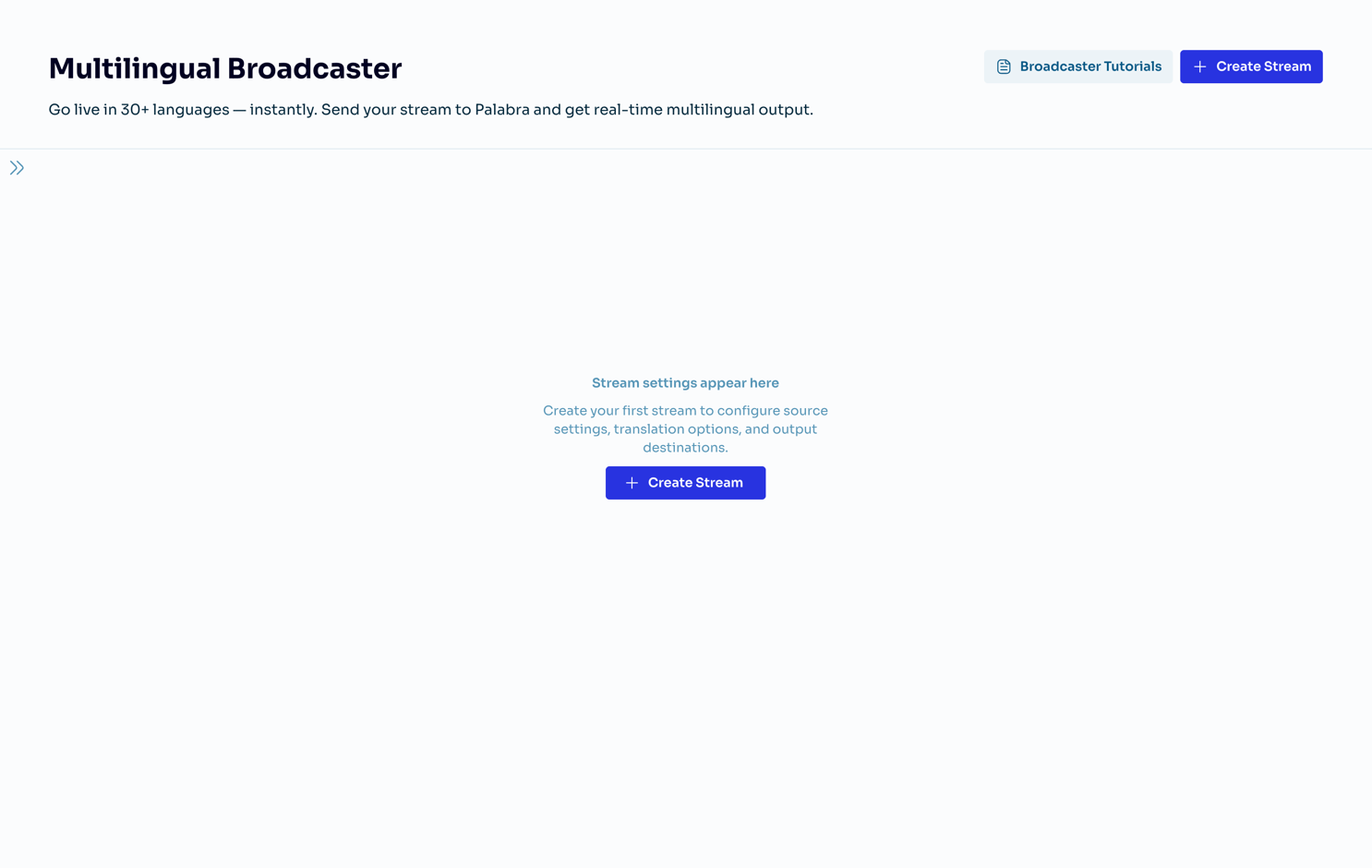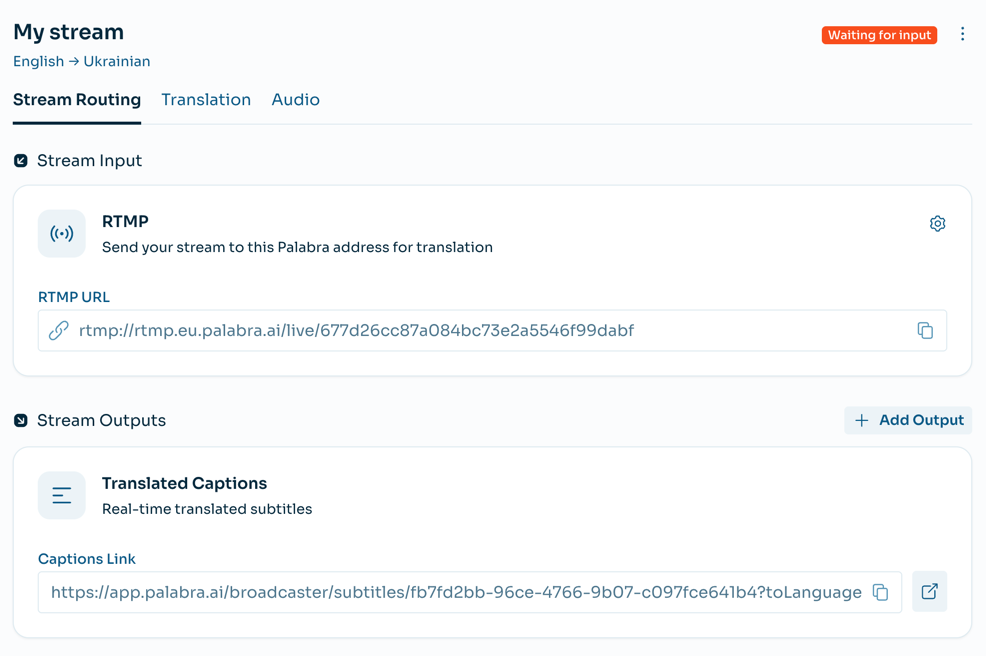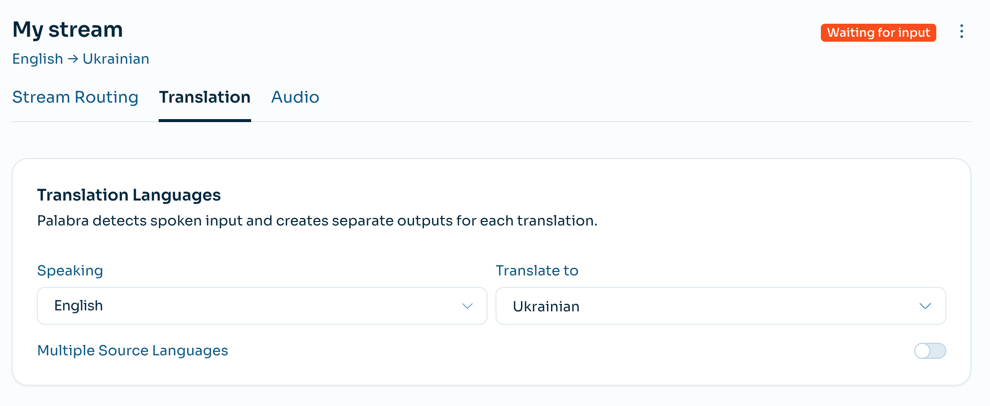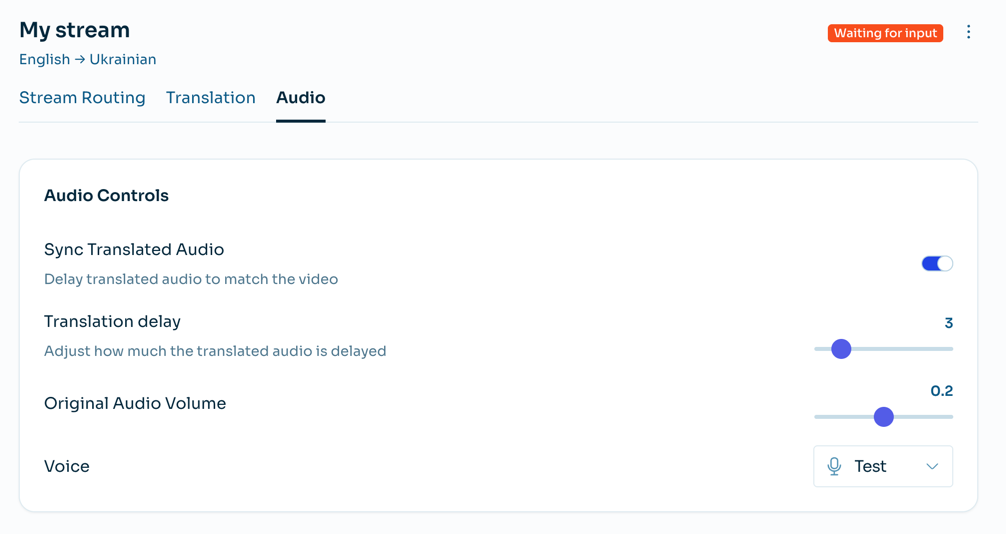Stream Translation with Palabra Broadcaster Web Service
This guide walks you through setting up a broadcaster using the Palabra web interface. The setup lets you stream live audio or video to Palabra for real-time translation and multilingual streaming for your events.
General Flow
- Create a Palabra account to access Broadcaster.
- Create a Stream and configure:
- input protocol (how Palabra receives your original stream)
- output protocol (how Palabra restreams the translated version)
- source language(s) for your original stream
- target languages to translate into (multiple languages in parallel are supported)
- optional settings to adjust your setup
- Send your stream to the Palabra server (or Palabra pulls it from your server, depending on the protocol).
- Palabra translates your stream in real time.
- Palabra restreams the translated version to your server or to a web player with low latency.
Accessing Broadcaster
- Open the Palabra web portal
- Log in to your Palabra account
- Navigate to the Broadcaster section

Broadcaster setup process
- Click Create Stream.
- Enter a name for your stream.
- Select the Input type (protocol).
- Choose RTMP or SRT if you're streaming from OBS Studio or similar software.
- Choose Microphone or Microphone + Camera if you want to stream directly from your device (great for offline events or quick live setups).
- Choose the languages for the broadcast:
- Speaking: the language the speakers will use.
- Choose one language, or enable "Multiple source languages" to specify several source languages if your original stream will include multiple languages.
- Translate to: the languages your stream will be translated into. The number of target languages is limited by your tariff.
- Speaking: the language the speakers will use.
- Click Create Stream.

After clicking Create Stream, you will see the Stream settings page.
Stream settings
The stream settings are divided into three sections (tabs): Stream routing, Translation, and Audio. Each section is described below.

Stream routing
The Stream routing section consists of one Input and one or more Outputs.
- Input:
- You the input type you have chosen on previous step.
- You cannot delete the input, but you can change it (for example, switch to another source).
- Outputs:
- You have one "Captions" output by default.
- You can add new outputs, edit existing ones, or remove them.
INPUT CONFIGURATION
Input configuration depends on the input type you chose when creating the stream.
| Input type | Description | Configuration |
|---|---|---|
| RTMP | Displays the RTMP URL to which you should send your original stream. | No configuration in Palabra. Point your encoder to this URL. |
| SRT | Displays the SRT URL to which you should send your original stream. | No configuration in Palabra. Point your encoder to this URL. |
| Microphone | Lets you select a microphone and start streaming directly from the Palabra web interface. Audio only. | Select a microphone and click "Start streaming", when you are ready. |
| Microphone + Camera | Lets you select a microphone and camera and start streaming from the Palabra web interface. | Select devices and click "Start streaming", when you are ready. |
Notes for RTMP and SRT inputs:
- You can switch the URL layout by clicking the gear icon in the top-right corner. Disabling the Single URL field setting splits the URL into separate fields (useful for some software).
- As soon as you start streaming to Palabra, the stream status changes to Active and translation begins automatically.
How to change the input type:
- Click the gear icon in the top-right corner of the "Input" block on the "Stream routing" tab.
- Choose a different input type from the dropdown.
- Click Apply changes in the bottom bar.
OUTPUTS CONFIGURATION
The Outputs section lets you configure the destination and format of the translated stream.
You start with a default "Captions" output, and you can add more outputs to get the translated stream in different formats in parallel.
Available outputs:
| Output type | Description | Configuration |
|---|---|---|
| Captions | Provides a link to a page that shows original and translated captions in real time, and can optionally play audio for a chosen language. | No additional configuration. Use the provided link. You can share this link with anyone, it is available without authorization. |
| RTMP | Provides fields where Palabra restreams the translated RTMP to your server. One input per target language to stream each translation as a separate RTMP stream. | Fill in your server URL (with Stream Key included). Or disable "Single URL field" in the block's menu to enter URL and Stream Key separately. |
| SRT | Provides a single field where Palabra restreams the translated SRT to your server. All target-language tracks are multiplexed into the same stream, so there is only one input (unlike RTMP). | Fill in your server URL (with Port and Stream Key included). Or disable "Single URL field" in the block's menu to enter URL, Port, and Stream Key separately. |
Captions with Audio
If you want to hear the audio translation on the Captions page:
- enable the "Captions with audio" toggle inside the "Captions" output block
- click Apply changes
- use the additional link that contains Captions with Audio.
You can share this link with anyone - it’s accessible without authorization.
How To add a new output
- Click the Add output button in the top-right corner of the Outputs section.
- Select the desired output type.
- Fill in the required fields.
- Click Apply Changes to save it.

Translation
In this section, you can add, edit, or remove stream languages.
After making any changes, click Apply changes to save.
Note: The number of target languages is limited by your tariff.

Audio
In this section, you can configure your stream's audio settings:
- Sync translated audio: Keep translated audio synchronized with the original by slightly shifting the original stream to reduce latency between original and translation.
- Translation delay: Adjust the timing offset (in seconds) used for "Sync translated audio".
- Original base volume during translation: Background volume of the original track when the translation track is playing but no translated speech is active.
- Original ducked volume during translation: Background volume of the original track when the translation track is playing and translated speech is active.
- Voice: Select the voice used to translate your speech. You can optionally use your own cloned voice for a more personalized result.
- Multiple speaker voices: Use different voices for speakers with high and low voice timbre.
For more details, see the Voices section.

Starting a Stream
To start streaming:
- Make sure you have at least one output.
- Fill in the required fields.
- Click Apply changes (if shown) to save.
- Then do one of the following:
- Click Start streaming in the Input section if your input is "Microphone" or "Microphone + Camera".
- Or start sending your external stream to Palabra if your input is "RTMP" or "SRT".
Translation and restreaming start automatically within 5–30 seconds.